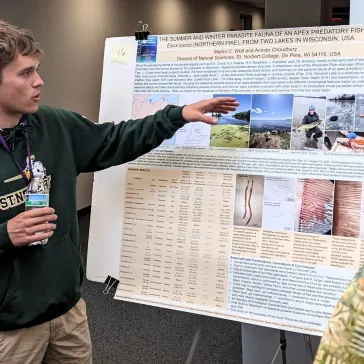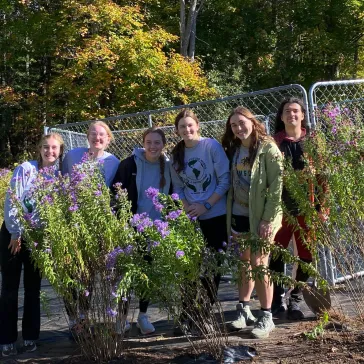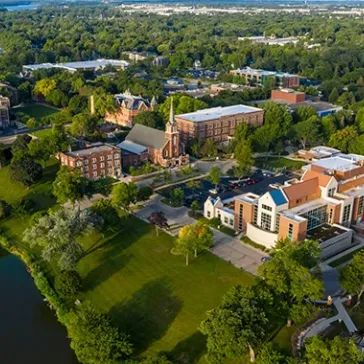-
Helpful info for
- Apply
- Visit
- Give
Popular SearchesNewsFishing for discovery: St. Norbert student uncovers hidden stories beneath Wisconsin’s waters Posted on Oct. 28, 2025
When biology major and avid angler Martin Wolf ’27 casts a line into Castle Rock Lake, he’s doing more than pursuing his favorite hobby, he’s exploring the hidden relationships that shape the health of Wisconsin’s waterways.
What began as a love of fishing turned into a two-year scientific investigation that reeled in groundbreaking data and earned Wolf the Raymond M. Cable Award at the 76th American Midwest Conference of Parasitologists, recognizing his outstanding undergraduate research presentation.
Turning a passion into purpose Anindo Choudhury (Biology and Environmental Science) immediately recognized Wolf’s potential as a researcher.
“Martin lives on Castle Rock Lake and is an avid and expert angler,” says Choudhury. “From his excitement and interest, I knew this was a natural fit.”
Castle Rock Lake is located in Central Wisconsin between Adams County and Juneau County. Several rivers and creeks flow into it, including the Yellow River.
Together, student and professor designed a study focused on the parasites of the Northern Pike, one of the region’s top predator fish, specifically in lake environments. By evaluating parasites, Wolf has uncovered valuable information about fish health, diet and the ecosystems they inhabit.
“Looking at the parasites in the fish can help tell us what the fish are interacting with in their environment and their overall health,” Wolf says.
Parasites are vital to research like this. They cause disease and death in local fish, and since parasites rely on several different hosts in their life cycle, they contain details about the hosts’ biology. Once published, the research will improve the public’s general knowledge and provide invaluable information to natural resource managers and biologists employed at fisheries.
The science beneath the surface Wolf’s research is groundbreaking: it’s the first study on pike (or any fish) parasites in the lower Wisconsin River; the first comprehensive seasonal study (two years of winter and summer sampling) of fish parasites in Wisconsin; and the first of its kind in the state since 1944. The last study from the Wisconsin River only contained a small sample of 27 pike in the upper basin.
Over multiple seasons, Wolf has examined dozens of Northern Pike — 72 to be exact — and has also identified and cataloged 20 parasite species.
“Martin’s study is generating new scientific knowledge on several fronts. It provides insight into the biology and ecology of an important apex predator fish.”
Anindo Choudhury
Among Wolf’s discoveries? A surprising menu of what these fish actually eat.
“Through dissections, we’ve found a wide range of prey items, from small fish like bluegill and perch to larger fish such as bass and even other pike,” he says. “Occasionally, we’ve even found fishing lures and hooks inside their stomachs.”
For Wolf, this connection between diet and parasites revealed how tightly woven the web of aquatic life can be and how environmental changes ripple through the ecosystem.
Choudhury also explains that this specific project tests the effects of lakes on the parasites themselves and how apex predators like the pike structure food webs and impact the biology of other fish. Ultimately, this study provides a pioneering baseline for comparison whenever similar studies are undertaken in the future.
Growth in the lab and beyond What started as fieldwork with a fishing rod evolved into a deep dive into microscopy, data collection and scientific storytelling.
Choudhury works very closely with his students on their research presentations. They plan out the content and results to highlight, discuss a title that captures the work and brainstorm what images help introduce an audience to the subject matter. When the presentation is created, the student then rehearses it with him, allowing Choudhury ample time to offer tips on how to effectively tell their research story.
“Over time, Martin has become more proficient and taken greater control of the work,” he says. “He’s more conscious and appreciative of the significance of his findings.”
That growth was on full display when Wolf presented his research titled “The parasite fauna of an apex predatory fish, Esox lucius (Northern Pike), from two lakes of the Wisconsin River drainage” to scientists from across the country at Winona State University in Minnesota this past June.
“It was definitely intimidating at first,” he says. “I was a bit concerned whether I could answer their questions, but once I started, I felt comfortable and confident talking about my project.”
His presentation skills first took shape at the St. Norbert College Undergraduate Research Forum, an experience that helped prepare him for the professional stage.
“It really helped me feel ready to share my research,” he adds.Recognition and reflection When Wolf’s name was announced as the winner of the Cable Award, he was both surprised and grateful.
“I’m honestly still surprised I won,” he admits. “There were so many other students whose work I admired. It feels good to know that some of the hard work I’ve put into the project has been recognized.”
Choudhury attributes that success to more than just technical skill. It’s also about SNC’s research culture.
“The sciences at SNC have a long tradition of faculty-mentored student research,” he explains. “This legacy fires students’ imaginations and shows them what’s possible.”
Hallways in the Gehl-Mulva Science Center are covered with research posters from students and faculty mentors past. All biology faculty have an active research program with a lab that has several student researchers coming and going.
“The St. Norbert Collaborative: Center for Undergraduate Research also highlights this high-impact practice and provides stipend and material support for student research throughout the year,” explains Choudhury. “There are also numerous subject-specific endowments for undergraduate research.”
Wolf’s project is supported by the James R. Hodgson Research Fellowship (2024 and 2025) and SNC Collaborative Research grants. The fellowships’ namesake, Jim Hodgson (Biology, Emeritus), was a long-time member of the biology discipline at St. Norbert until his retirement in 2016.
For Choudhury, undergraduate research like Wolf’s also embodies the essence of a liberal arts education.
“Research fosters critical thinking and understanding how various facets of inquiry and knowledge are interconnected. It delivers the joy and excitement of discovery and new knowledge,” he says. “Students also learn to solve problems, adapt to changing circumstances and communicate effectively. All of these habits of the mind and skills are fundamental aspects of a modern liberal arts education.”
From casting lines to collecting data, Wolf’s journey shows that science doesn’t just happen in the lab — it starts with curiosity, passion and the willingness to dive deeper.
“Do it! Research at SNC is a great experience,” urges Wolf. “The professors are supportive and fun to work with, and you get the chance to build connections with your labmates.”Looking ahead Wolf’s next steps include completing the final sampling season, conducting molecular analyses and writing his undergraduate thesis with plans to publish his findings.
Even though his long-term goal is to become a physician assistant, he says the research experience has profoundly shaped how he approaches science and problem-solving overall.
“This project has given me a deeper appreciation for scientific practices and the importance of asking questions,” he says. “Those skills will carry into my future health care career.”Related News
- Helpful info for



